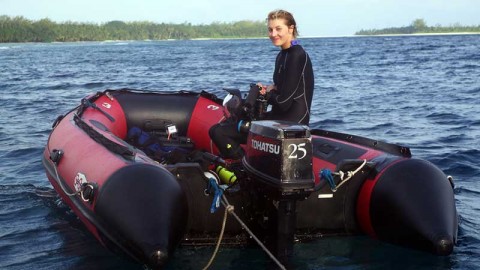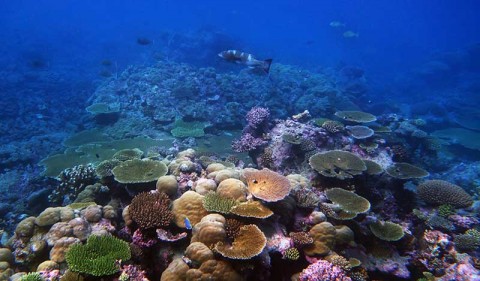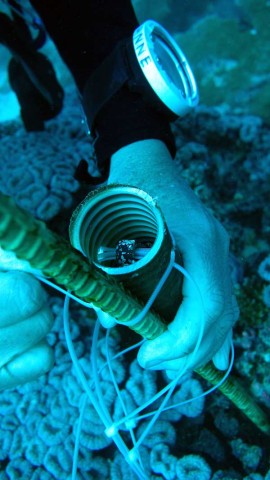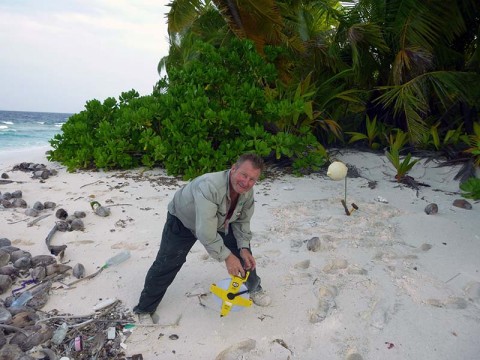BIOT Science Expedition 2014 - Coral gardens – Day 11
Coral gardens

Last night the clouds cleared their curtain away revealing the stars and so today dawned with blue skies and sunshine. A welcome change and just the right conditions to enjoy a couple of superb sites in the lagoon close to our overnight spot. Whereas Oceanside reefs can often be battered by storms from the open sea which break up larger coral formations, those corals in the lagoons can develop with unconstrained grandeur.

Today we broke the surface to find diverse gardens of thriving coral stretching in each direction awaiting our exploration. On completion of dives our scientists returned to the surface with smiling faces and phrases rich with superlatives for the environment below.
Although the condition of these reefs is largely due to their remoteness from human civilization, they are not completely removed from humanities influence. There is much debate over global warming and temperature is one of the things that is being measured here in the Chagos Archipelago. Anne has a few words on this work.

“When 90% of corals were killed in the Indian Ocean in 1998 due to a huge warming event, we were dismayed to see that the Chagos reefs had been hit just as badly as the rest. But the following few years showed the corals returning and surveying the amount of new, live, coral and comparing that figure to coral cover data that we had from the late 1970s, showed that Chagos, unlike most of the rest of the Indian Ocean, was recovering, and recovering remarkably well.

As a result of this we have been regularly monitoring the seawater temperature (in case of another warming event), the coral cover and the recruitment of new, juvenile, corals on the Chagos reefs. Data loggers record the seawater temperature every two hours and can store the accumulated data - the batteries can last for three to four years. Every expedition we download the data from the loggers and replace them, but the trick is finding them again each time! We have GPS coordinates for each one, and these are now remarkably accurate, but it still sometimes takes a good bit of searching to locate one small length of rebar with a six inch piece of plastic pipe cable tied to it. Often it is because the rebar is the only straight thing on the reef that gives it away. The logger is in the plastic pipe to stop it being bitten by parrotfish.

There have been other small warming events in recent years but thankfully nothing like the episode in 1998. Chagos reefs have recovered better than almost anywhere else in the Indian Ocean, with only a very few small areas having recovered as well. The pattern of recruitment is interesting, with parallels with terrestrial vegetation - first come the weeds then comes the forest. The huge Acropora tables seem to be the weeds - very beautiful weeds certainly - and we are now seeing large numbers of them die off. Is this natural senescence or something else?

The numbers of juvenile corals we are seeing is vast. Last year they were tiny spots seen through a hand lens, this year they are all bigger and much more obvious. Dead Acropora tables are a favourite base for them to settle on and it remains to be seen what will happen to these juveniles when the Acropora tables break up and erode. The tables may possibly (hopefully) become cemented onto the reef in some cases and allow the young corals to continue to grow.”
As we were examining the world beneath the waves Pete continued his terrestrial efforts with our intrepid expedition Doctor in tow.

“The weather was calm enough this morning for Jon Bailey and me to head to the island where it is hoped a rat eradication attempt will be carried out later this year. We intended to “kill several birds with one stone” (excuse the pun!) today. The most pressing job was to identify and prepare transect lines to survey this island for Coconut Crabs. This would be extremely useful data to gather for three reasons. The most important being it will facilitate a before and after rat eradication analysis of their numbers, along with bird, turtle, hermit crab and vegetation information gathered already. This is vital information in order to assess the impact of removing invasive introduced predators from an oceanic island ecosystem. The intent is also to compare this island’s Coconut Crab density and demographics with a rat-free island we hope to visit later in the expedition and also with a control site that is not harvested on Diego Garcia.

The second bird to fall was to map and establish the grid system that requires cutting in to the island’s vegetation in order to disperse rat poison later this year. To achieve at least in part this goal, the Coconut Crab transects were doubled up as grid-lines. The actual days work involved recording way points and physically marking key points, following compass bearings, using measuring wheels and the cutting of 300m of transect lines, not to mention swimming ashore with iron marking posts!. This was hot, hand-blistering work but a fun and essential day to the long-term ecological improvement of these islands.”


